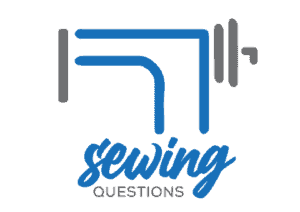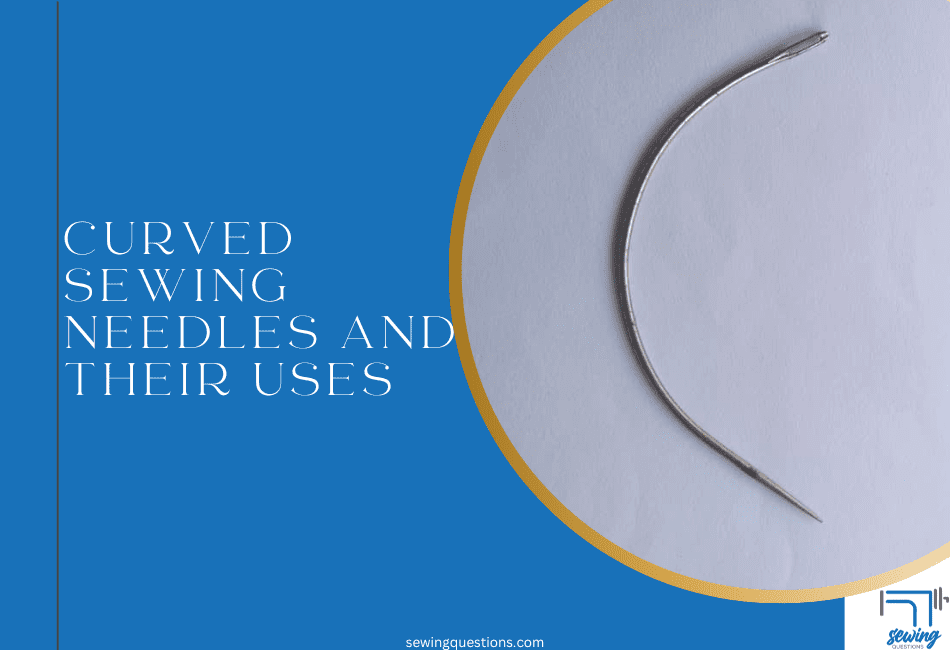The art of sewing has evolved so much in design, creativity, and processes. Making certain designs requires specialized tools and materials. One such tool is a curved sewing needle.
If you are new to sewing, this may be a mystery to you but If you have been sewing for a while, you know that there are different types of needles used for various purposes. One type of needle that is often used is the curved needle.
In this blog post, we’ll explore why these needles are curved and what some of their common uses are. By the end, you’ll have a better understanding of how to use them to your advantage when sewing.
What Are Curved Needles And Why Are They Curved In The First Place?
Curved needles are one of the most versatile types of hand tools used in sewing. As the name suggests, they are not straight needles. They have a semi-circular shape or a gentle arch which makes them so easily grasped within the palm and maneuvered with great accuracy by a user’s fingertips.
This ergonomic design was originally created to enable crafters to reach tight spaces between stitching, allowing them to make intricate patterns without overextending their hands. In addition, curved needles reduce the risk of fabric snagging on hard angles as can happen when using sharper-angled needles that don’t flex as well.
There are several reasons why curved needles are preferred over straight needles.
- First, the curved shape allows the seamstress to sew in a variety of directions without having to turn the needle each time. This increases efficiency and reduces wasted time.
- Secondly, the curved shape enables them to be used for precise, detailed stitching.
- Additionally, curved needles can easily slide through thicker materials and fabrics that would otherwise be difficult to penetrate with a straight needle.
- Finally, the curved shape also helps to provide better visibility while sewing. This makes it easier for sewers to see what they are working on and reduces the number of errors.
Whether you’re working on your own project or assisting someone else with theirs, understanding the uses of curved sewing needles will ensure each stitch looks uniform and neat.
All in all, curved needles are an excellent choice for completing nearly any kind of craft-related sewing or repairs that you may need to do with precision and care. Given their uses and functionality, they should definitely be part of every seamstress, leatherworker, and crafter’s toolbox.
What Are Curved Needles Used For?
As I indicated earlier, curved needles can be used for a variety of things. Basically, we might need to use a curved needle for any occasion where a straight needle might be a bit awkward or difficult to use. Here are some of its common uses:
1. Sewing Through Heavy Fabric
If you are sewing through a really heavy fabric curved needles can help make the job easier. They are curved so that they can get through the fabric without snagging or damaging it.
The curved needles are helpful if you don’t want to put a lot of muscle into the work so that your fingers don’t hurt just by virtue of having to push really hard into the fabric and trying to force and manipulate your fabric and the layers in such a way that you get that needle through the fabric and the edges.
If you want to join two pieces of fabric together and the fabric doesn’t flex so well, a curved needle works really well.
2. Mounting Embroidery
Curved needles are great for mounting embroidery around a board. In most cases, you cannot flex the board to move it to get a straight needle in. This is where curved needles come in handy as they can easily enter and come out of the fabric without you worrying about struggling to flex the board or hurting your fingers in trying to force the needle to go through.
3. Beadworking
Curved needles can also be used for beading. It is much easier to manipulate curved needles when working with beads and sequins as it gives you a better sense of control.
The curve helps to keep the beading thread secure within the bead hole by providing extra tension, reducing frustrations with slipping or slipping out-of-place beads.
In a nutshell, they allow beaders to effortlessly string a variety of beads.
4. Sewing Seams in Tight Spaces
If you’re working with a curved seam, curved needles can be very useful. They can easily maneuver through curved seams and tight spaces, allowing you to perfectly stitch around curved edges without having to turn the needle each time.
For example, sewing the square edge of a cushion, repairing the damaged seam at the edges of your leather car seat, or sewing curved hemlines can be done quickly and easily with the help of curved needles.
5. Repairing Items With Seams That Cannot Be Flattened
Some items cannot fit under a sewing machine or are flattened during repairs and the only tool that can help you carry on with the repair work is a curved needle.
Examples of items that cannot be flattened include mattresses, stuffed pillows or cushions, lampshades, and furniture coverings on items such as armchairs and sofas.
That is why they are sometimes called curved upholstery needles.
How To Use A Curved Needle Correctly
Curved needles are perfect for stitching through thick fabrics and sections of the fabric that are difficult to access. The curved design not only provides a much smoother sewing experience, but it can also simplify complex hand-stitching tasks; this makes already time-consuming construction even faster in the long run.
The curved needle is used differently than the way you would use a straight one. If you use it normally like a straight needle, you will probably snap the needle. So there are certain techniques and angles at which you should work properly. The main difference has to do with movement.
To have much control over where the needle is going, you need to get three fingers on it. Put two fingers underneath and your thumb on top of the needle. It is not practical to use two fingers to hold the needle because you cannot control the needle and it is going to bend all over the place.
Now, because the needle is curved you can’t obviously put it in the material straight. You need to curve the needle up and dig it down into the fabric with the point. If you realize that you are struggling and the curved needle won’t go in, it’s because your technique is not right. So always try and use the pointed tip to help you get into the fabric or material.
When the needle gets into the material, you need to curve your hand around because if you just go straight the needle will disappear straight at the bottom. To get it to come back out again, you have to use that same curve motion until you see it sticking up there. That way you can choose how long you want the stitch to be.
Remember that if you put any strain on it that’s when you bend it, you may snap it. So, rather than working against your tools, work with them.
Some Tips And Tricks For Sewing With A Curved Needle
Using a curved needle when sewing can be a great way to save time and enable you to create more complex designs with ease. However, it does require some practice and skill to ensure that your stitches remain consistent and secure.
The first thing you should consider is the type of material that you are using. Depending on the fabric, different lengths and thicknesses of curved needles may be necessary for successful stitching.
Similarly, choosing the correct thread type is also important for ensuring that your stitches remain tight and secure.
If you’re hesitant about how to use a curved needle, then practice stitching open lines on a spare piece of fabric or paper before tackling your project.
Finally, don’t forget to adjust the tension of your thread loop as you sew to ensure even distribution along the length of each stitch.
With these tips in mind, it soon becomes clear why learning how to work successfully with a curved needle opens up new possibilities when it comes to creative sewing projects.
Can You Curve A Straight Needle?
Unfortunately, the curved shape of a curved needle is not something that can be replicated with a straight one. While you may be able to bend a straight needle a little bit to make it curved, this could cause the needle to snap and become unusable.
I know some people have succeeded in bending a straight needle a little bit. I have as well. But beyond that little bit, the needle will snap.
If you also succeed in bending it more, the curve will never be as smooth as a curved needle. So, it’s not recommended that you try to bend a straight needle into a curved shape.
If you need to sew with a curved needle, simply buy one. They are widely available on the market. there is no need to destroy your straight needles and put yourself at risk of injuries.
Final Thoughts
Crafting projects can often require specialized tools in order to achieve optimal results. And when it comes to stitching projects, one such useful tool is a curved needle. While traditional straight needles are capable of performing many basic tasks, curved needle needles offer a number of advantages that can make working on certain projects much easier.
Because of their shape, curved needles will naturally pull the thread through the fabric more easily, making them ideal for tasks like closing up stuffed toys or quilting dense fabrics. While they may be more difficult to find than straight needles, once you get your hands on a curved needle you’ll find that its superior capabilities far outweigh any initial difficulties in acquiring it.
Plus, you may also discover that using a curved needle can save time and effort on larger projects. So if you’re looking to make your next crafting project as easy and enjoyable as possible, it’s definitely worth making sure your kit includes a curved needle.

